Sustainable Tourism: Development, Planning, and Impact in Philippines
VerifiedAdded on 2020/06/04
|19
|5341
|65
Report
AI Summary
This report provides a comprehensive analysis of sustainable tourism development in the Philippines. It examines the benefits for stakeholders from tourism planning, the advantages and disadvantages of public-private sector partnerships, and the significance of interactive planning systems. The study also explores tourism development planning at various levels (national, international, regional, and sub-regional) and methods for measuring tourist impact. Furthermore, the report discusses the conceptual framework of sustainable tourism, factors preventing sustainable development, and stages in planning for sustainability. It addresses conflict resolution, balancing supply and demand, and ethical issues related to enclave tourism in the Philippines. The report concludes by identifying current issues in tourism development and offering recommendations for the future of the tourism business in the country.
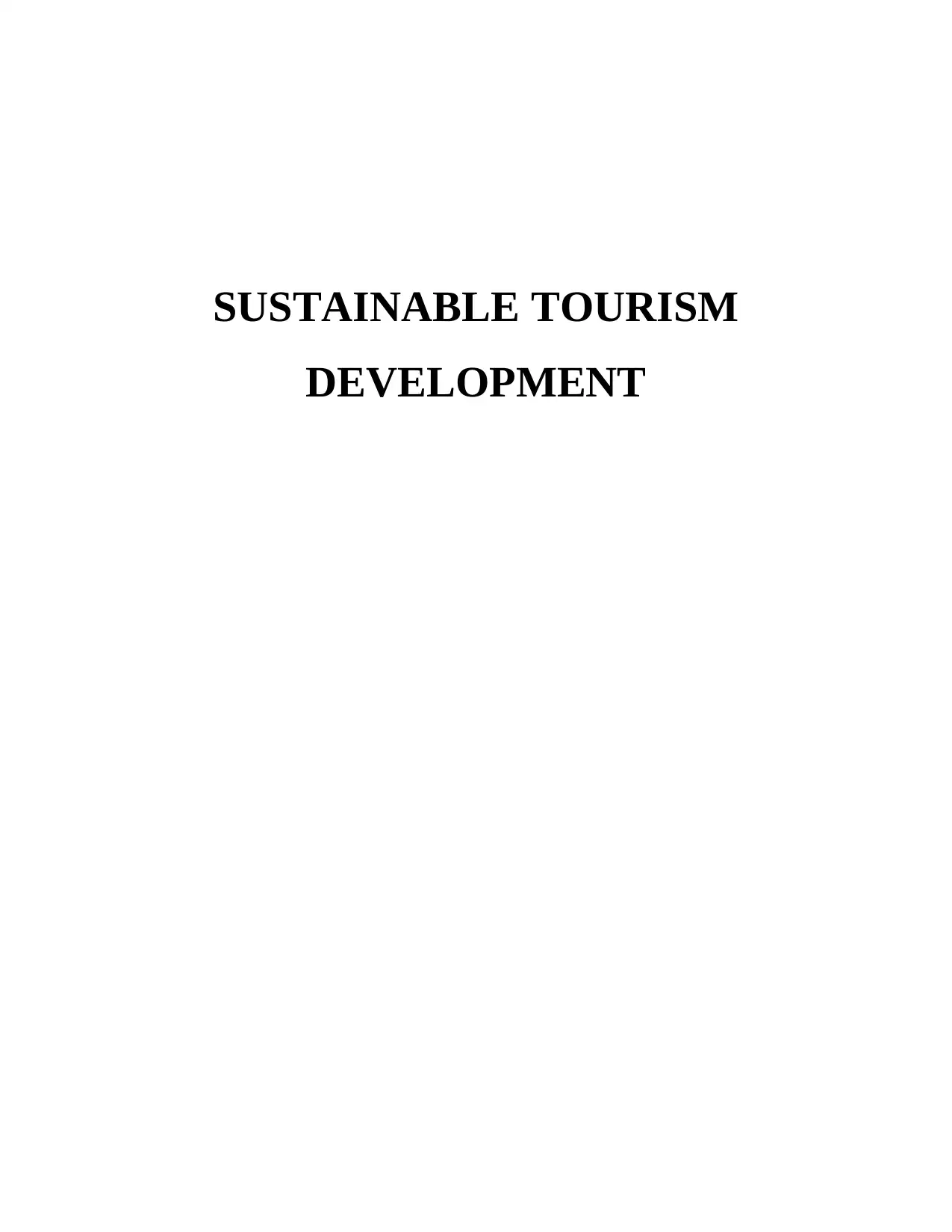
SUSTAINABLE TOURISM
DEVELOPMENT
DEVELOPMENT
Paraphrase This Document
Need a fresh take? Get an instant paraphrase of this document with our AI Paraphraser
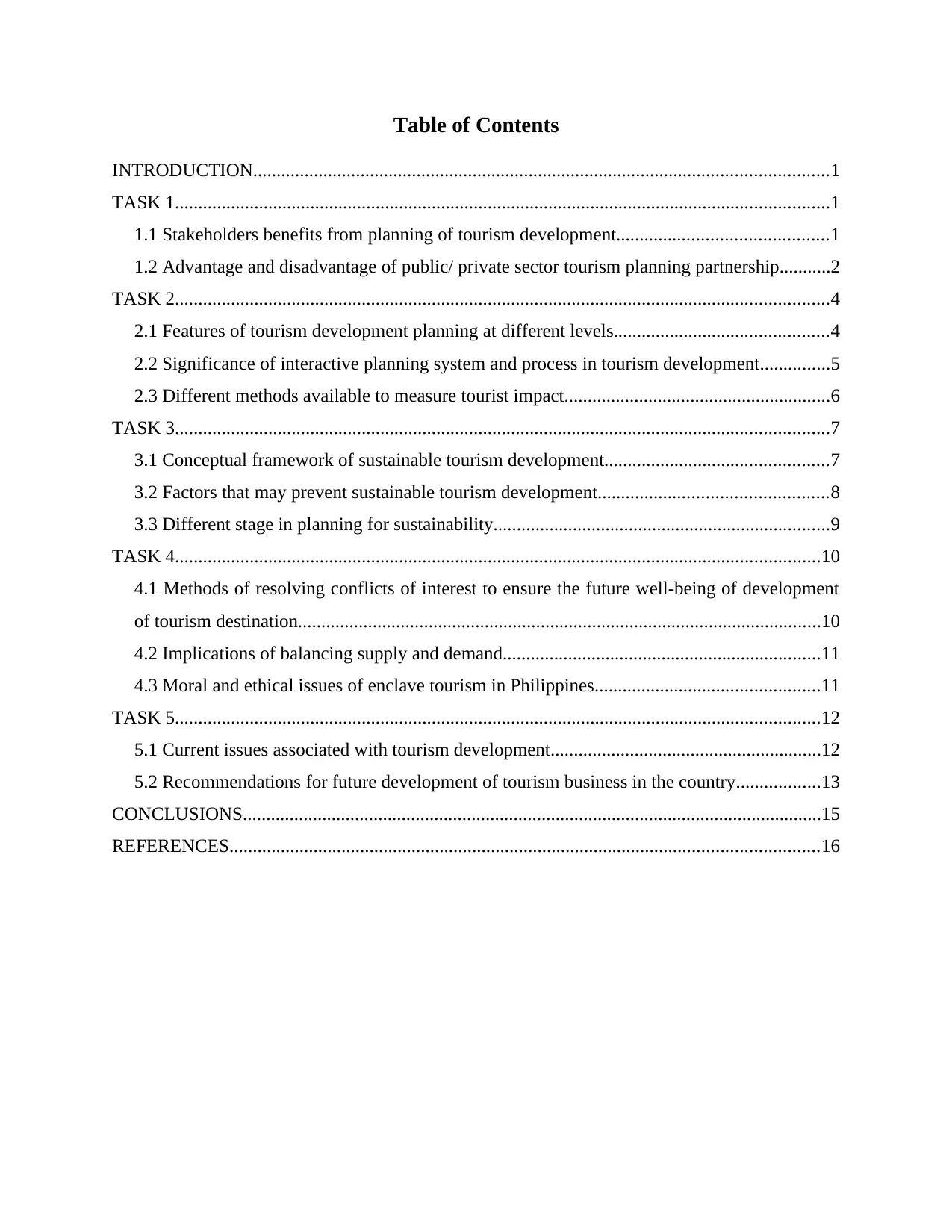
Table of Contents
INTRODUCTION...........................................................................................................................1
TASK 1............................................................................................................................................1
1.1 Stakeholders benefits from planning of tourism development.............................................1
1.2 Advantage and disadvantage of public/ private sector tourism planning partnership...........2
TASK 2............................................................................................................................................4
2.1 Features of tourism development planning at different levels..............................................4
2.2 Significance of interactive planning system and process in tourism development...............5
2.3 Different methods available to measure tourist impact.........................................................6
TASK 3............................................................................................................................................7
3.1 Conceptual framework of sustainable tourism development................................................7
3.2 Factors that may prevent sustainable tourism development.................................................8
3.3 Different stage in planning for sustainability........................................................................9
TASK 4..........................................................................................................................................10
4.1 Methods of resolving conflicts of interest to ensure the future well-being of development
of tourism destination................................................................................................................10
4.2 Implications of balancing supply and demand....................................................................11
4.3 Moral and ethical issues of enclave tourism in Philippines................................................11
TASK 5..........................................................................................................................................12
5.1 Current issues associated with tourism development..........................................................12
5.2 Recommendations for future development of tourism business in the country..................13
CONCLUSIONS............................................................................................................................15
REFERENCES..............................................................................................................................16
INTRODUCTION...........................................................................................................................1
TASK 1............................................................................................................................................1
1.1 Stakeholders benefits from planning of tourism development.............................................1
1.2 Advantage and disadvantage of public/ private sector tourism planning partnership...........2
TASK 2............................................................................................................................................4
2.1 Features of tourism development planning at different levels..............................................4
2.2 Significance of interactive planning system and process in tourism development...............5
2.3 Different methods available to measure tourist impact.........................................................6
TASK 3............................................................................................................................................7
3.1 Conceptual framework of sustainable tourism development................................................7
3.2 Factors that may prevent sustainable tourism development.................................................8
3.3 Different stage in planning for sustainability........................................................................9
TASK 4..........................................................................................................................................10
4.1 Methods of resolving conflicts of interest to ensure the future well-being of development
of tourism destination................................................................................................................10
4.2 Implications of balancing supply and demand....................................................................11
4.3 Moral and ethical issues of enclave tourism in Philippines................................................11
TASK 5..........................................................................................................................................12
5.1 Current issues associated with tourism development..........................................................12
5.2 Recommendations for future development of tourism business in the country..................13
CONCLUSIONS............................................................................................................................15
REFERENCES..............................................................................................................................16
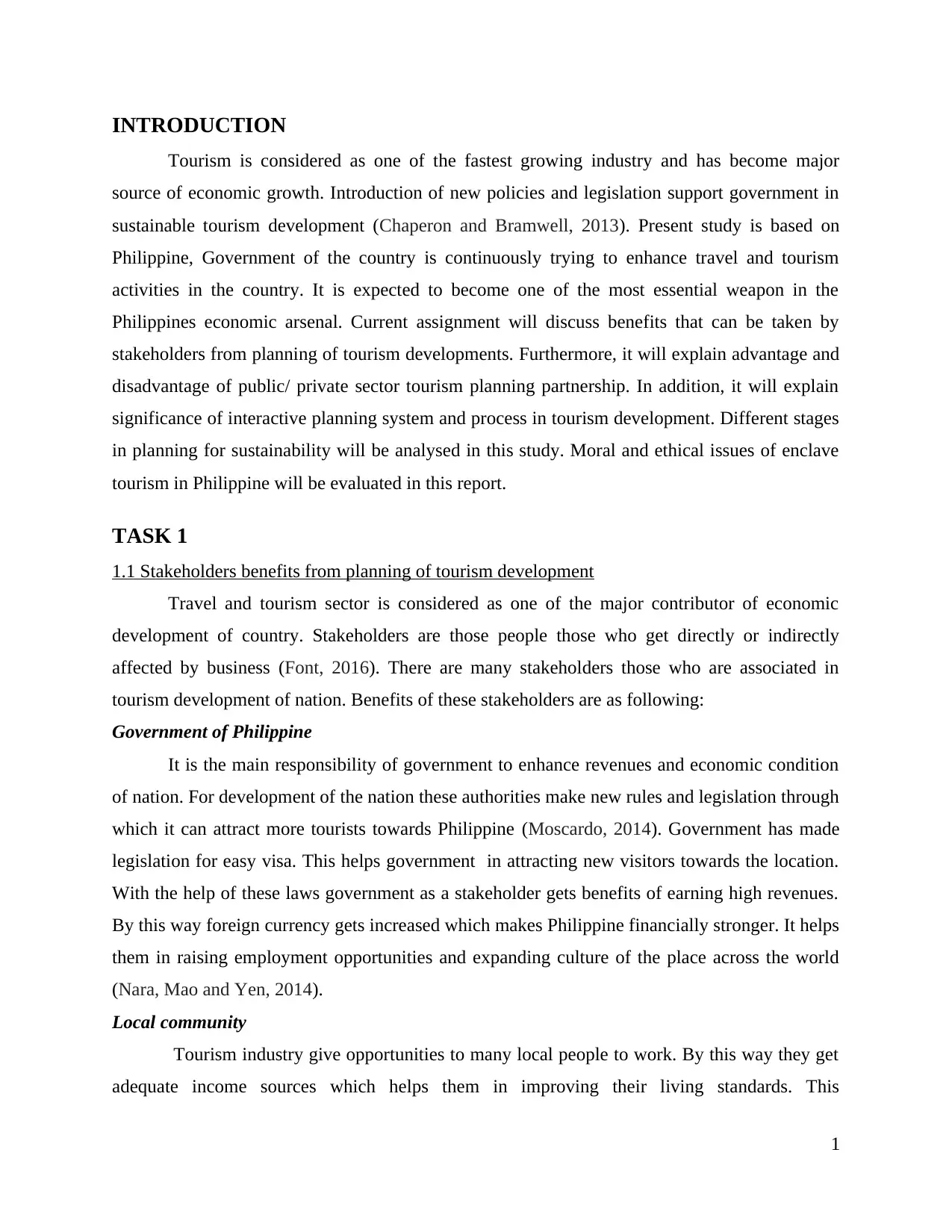
INTRODUCTION
Tourism is considered as one of the fastest growing industry and has become major
source of economic growth. Introduction of new policies and legislation support government in
sustainable tourism development (Chaperon and Bramwell, 2013). Present study is based on
Philippine, Government of the country is continuously trying to enhance travel and tourism
activities in the country. It is expected to become one of the most essential weapon in the
Philippines economic arsenal. Current assignment will discuss benefits that can be taken by
stakeholders from planning of tourism developments. Furthermore, it will explain advantage and
disadvantage of public/ private sector tourism planning partnership. In addition, it will explain
significance of interactive planning system and process in tourism development. Different stages
in planning for sustainability will be analysed in this study. Moral and ethical issues of enclave
tourism in Philippine will be evaluated in this report.
TASK 1
1.1 Stakeholders benefits from planning of tourism development
Travel and tourism sector is considered as one of the major contributor of economic
development of country. Stakeholders are those people those who get directly or indirectly
affected by business (Font, 2016). There are many stakeholders those who are associated in
tourism development of nation. Benefits of these stakeholders are as following:
Government of Philippine
It is the main responsibility of government to enhance revenues and economic condition
of nation. For development of the nation these authorities make new rules and legislation through
which it can attract more tourists towards Philippine (Moscardo, 2014). Government has made
legislation for easy visa. This helps government in attracting new visitors towards the location.
With the help of these laws government as a stakeholder gets benefits of earning high revenues.
By this way foreign currency gets increased which makes Philippine financially stronger. It helps
them in raising employment opportunities and expanding culture of the place across the world
(Nara, Mao and Yen, 2014).
Local community
Tourism industry give opportunities to many local people to work. By this way they get
adequate income sources which helps them in improving their living standards. This
1
Tourism is considered as one of the fastest growing industry and has become major
source of economic growth. Introduction of new policies and legislation support government in
sustainable tourism development (Chaperon and Bramwell, 2013). Present study is based on
Philippine, Government of the country is continuously trying to enhance travel and tourism
activities in the country. It is expected to become one of the most essential weapon in the
Philippines economic arsenal. Current assignment will discuss benefits that can be taken by
stakeholders from planning of tourism developments. Furthermore, it will explain advantage and
disadvantage of public/ private sector tourism planning partnership. In addition, it will explain
significance of interactive planning system and process in tourism development. Different stages
in planning for sustainability will be analysed in this study. Moral and ethical issues of enclave
tourism in Philippine will be evaluated in this report.
TASK 1
1.1 Stakeholders benefits from planning of tourism development
Travel and tourism sector is considered as one of the major contributor of economic
development of country. Stakeholders are those people those who get directly or indirectly
affected by business (Font, 2016). There are many stakeholders those who are associated in
tourism development of nation. Benefits of these stakeholders are as following:
Government of Philippine
It is the main responsibility of government to enhance revenues and economic condition
of nation. For development of the nation these authorities make new rules and legislation through
which it can attract more tourists towards Philippine (Moscardo, 2014). Government has made
legislation for easy visa. This helps government in attracting new visitors towards the location.
With the help of these laws government as a stakeholder gets benefits of earning high revenues.
By this way foreign currency gets increased which makes Philippine financially stronger. It helps
them in raising employment opportunities and expanding culture of the place across the world
(Nara, Mao and Yen, 2014).
Local community
Tourism industry give opportunities to many local people to work. By this way they get
adequate income sources which helps them in improving their living standards. This
1
⊘ This is a preview!⊘
Do you want full access?
Subscribe today to unlock all pages.

Trusted by 1+ million students worldwide
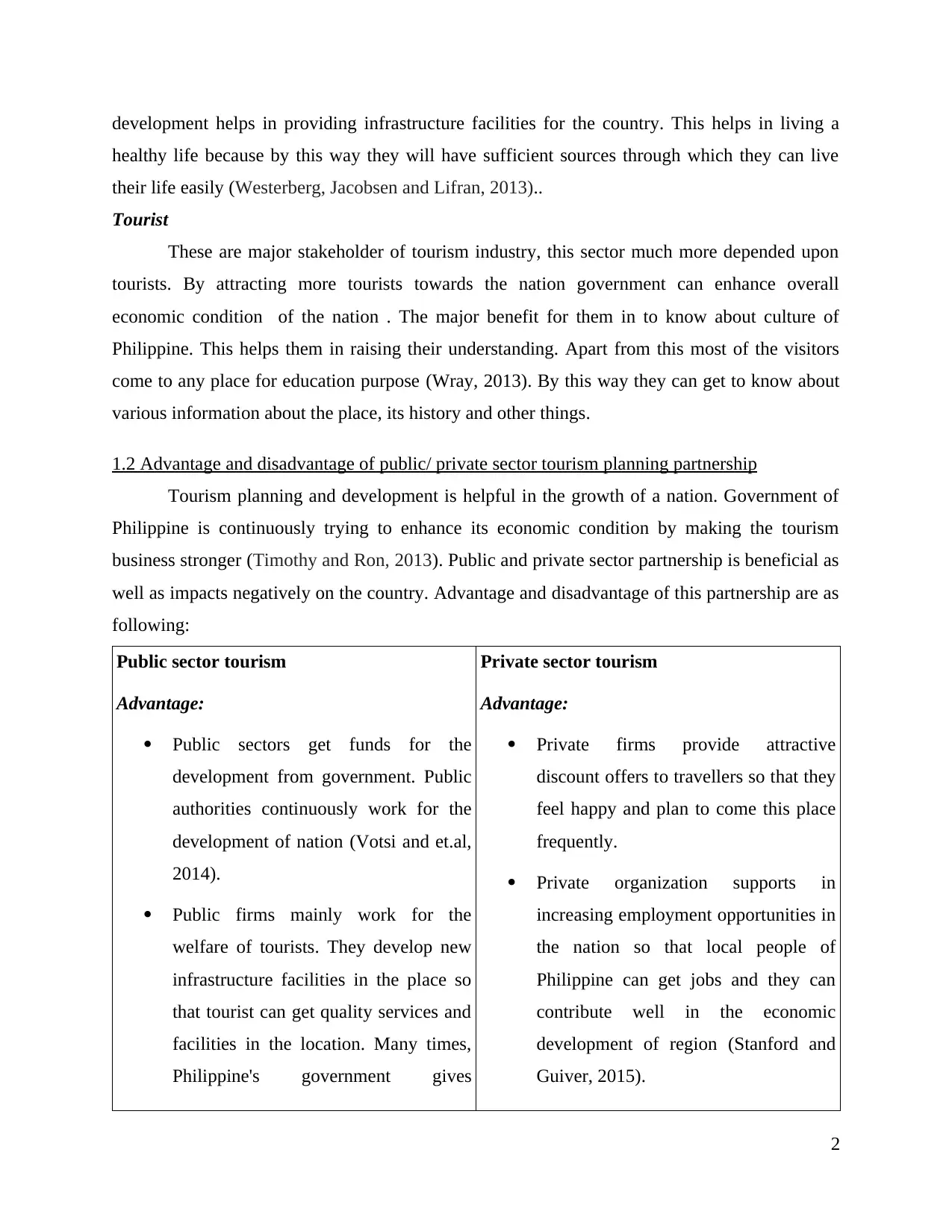
development helps in providing infrastructure facilities for the country. This helps in living a
healthy life because by this way they will have sufficient sources through which they can live
their life easily (Westerberg, Jacobsen and Lifran, 2013)..
Tourist
These are major stakeholder of tourism industry, this sector much more depended upon
tourists. By attracting more tourists towards the nation government can enhance overall
economic condition of the nation . The major benefit for them in to know about culture of
Philippine. This helps them in raising their understanding. Apart from this most of the visitors
come to any place for education purpose (Wray, 2013). By this way they can get to know about
various information about the place, its history and other things.
1.2 Advantage and disadvantage of public/ private sector tourism planning partnership
Tourism planning and development is helpful in the growth of a nation. Government of
Philippine is continuously trying to enhance its economic condition by making the tourism
business stronger (Timothy and Ron, 2013). Public and private sector partnership is beneficial as
well as impacts negatively on the country. Advantage and disadvantage of this partnership are as
following:
Public sector tourism
Advantage:
Public sectors get funds for the
development from government. Public
authorities continuously work for the
development of nation (Votsi and et.al,
2014).
Public firms mainly work for the
welfare of tourists. They develop new
infrastructure facilities in the place so
that tourist can get quality services and
facilities in the location. Many times,
Philippine's government gives
Private sector tourism
Advantage:
Private firms provide attractive
discount offers to travellers so that they
feel happy and plan to come this place
frequently.
Private organization supports in
increasing employment opportunities in
the nation so that local people of
Philippine can get jobs and they can
contribute well in the economic
development of region (Stanford and
Guiver, 2015).
2
healthy life because by this way they will have sufficient sources through which they can live
their life easily (Westerberg, Jacobsen and Lifran, 2013)..
Tourist
These are major stakeholder of tourism industry, this sector much more depended upon
tourists. By attracting more tourists towards the nation government can enhance overall
economic condition of the nation . The major benefit for them in to know about culture of
Philippine. This helps them in raising their understanding. Apart from this most of the visitors
come to any place for education purpose (Wray, 2013). By this way they can get to know about
various information about the place, its history and other things.
1.2 Advantage and disadvantage of public/ private sector tourism planning partnership
Tourism planning and development is helpful in the growth of a nation. Government of
Philippine is continuously trying to enhance its economic condition by making the tourism
business stronger (Timothy and Ron, 2013). Public and private sector partnership is beneficial as
well as impacts negatively on the country. Advantage and disadvantage of this partnership are as
following:
Public sector tourism
Advantage:
Public sectors get funds for the
development from government. Public
authorities continuously work for the
development of nation (Votsi and et.al,
2014).
Public firms mainly work for the
welfare of tourists. They develop new
infrastructure facilities in the place so
that tourist can get quality services and
facilities in the location. Many times,
Philippine's government gives
Private sector tourism
Advantage:
Private firms provide attractive
discount offers to travellers so that they
feel happy and plan to come this place
frequently.
Private organization supports in
increasing employment opportunities in
the nation so that local people of
Philippine can get jobs and they can
contribute well in the economic
development of region (Stanford and
Guiver, 2015).
2
Paraphrase This Document
Need a fresh take? Get an instant paraphrase of this document with our AI Paraphraser
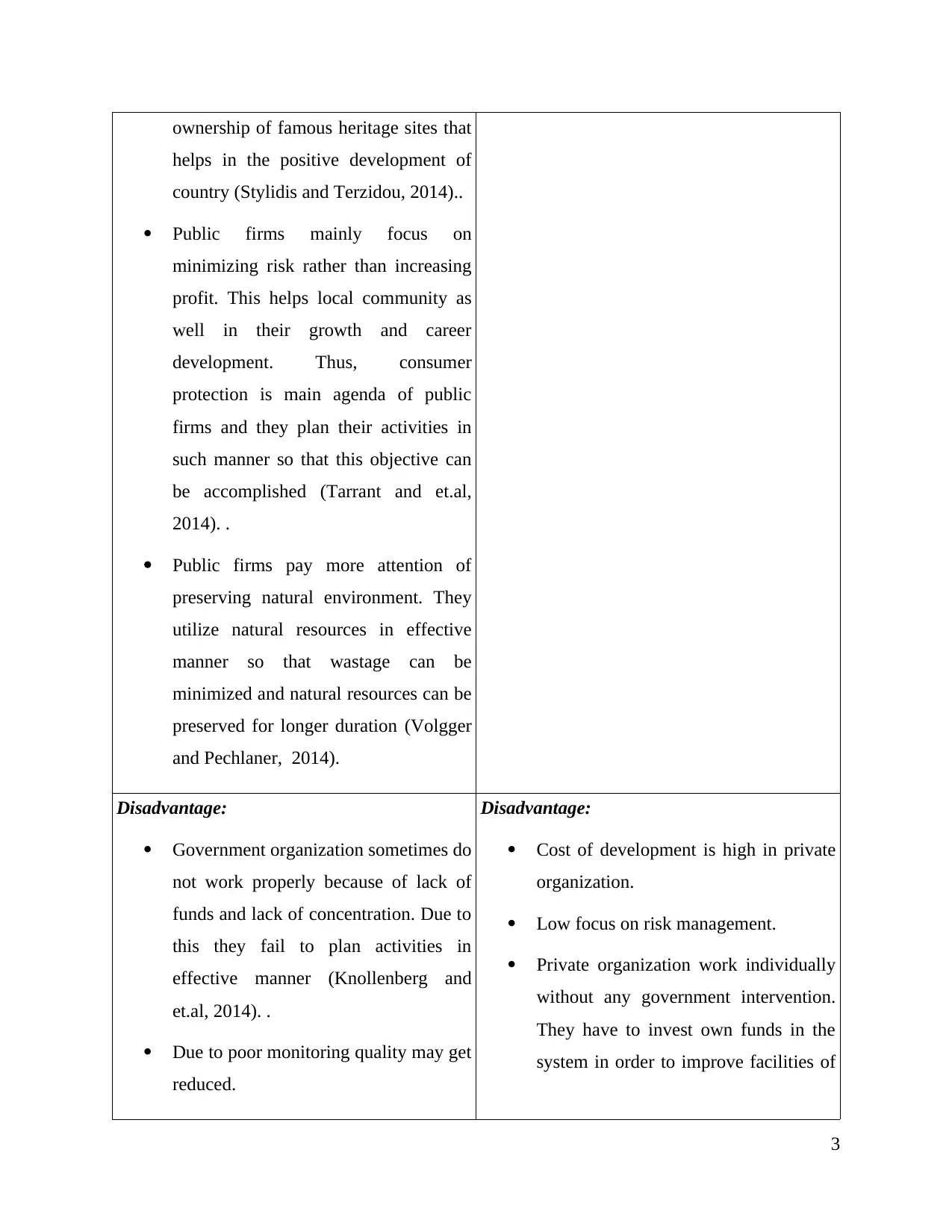
ownership of famous heritage sites that
helps in the positive development of
country (Stylidis and Terzidou, 2014)..
Public firms mainly focus on
minimizing risk rather than increasing
profit. This helps local community as
well in their growth and career
development. Thus, consumer
protection is main agenda of public
firms and they plan their activities in
such manner so that this objective can
be accomplished (Tarrant and et.al,
2014). .
Public firms pay more attention of
preserving natural environment. They
utilize natural resources in effective
manner so that wastage can be
minimized and natural resources can be
preserved for longer duration (Volgger
and Pechlaner, 2014).
Disadvantage:
Government organization sometimes do
not work properly because of lack of
funds and lack of concentration. Due to
this they fail to plan activities in
effective manner (Knollenberg and
et.al, 2014). .
Due to poor monitoring quality may get
reduced.
Disadvantage:
Cost of development is high in private
organization.
Low focus on risk management.
Private organization work individually
without any government intervention.
They have to invest own funds in the
system in order to improve facilities of
3
helps in the positive development of
country (Stylidis and Terzidou, 2014)..
Public firms mainly focus on
minimizing risk rather than increasing
profit. This helps local community as
well in their growth and career
development. Thus, consumer
protection is main agenda of public
firms and they plan their activities in
such manner so that this objective can
be accomplished (Tarrant and et.al,
2014). .
Public firms pay more attention of
preserving natural environment. They
utilize natural resources in effective
manner so that wastage can be
minimized and natural resources can be
preserved for longer duration (Volgger
and Pechlaner, 2014).
Disadvantage:
Government organization sometimes do
not work properly because of lack of
funds and lack of concentration. Due to
this they fail to plan activities in
effective manner (Knollenberg and
et.al, 2014). .
Due to poor monitoring quality may get
reduced.
Disadvantage:
Cost of development is high in private
organization.
Low focus on risk management.
Private organization work individually
without any government intervention.
They have to invest own funds in the
system in order to improve facilities of
3
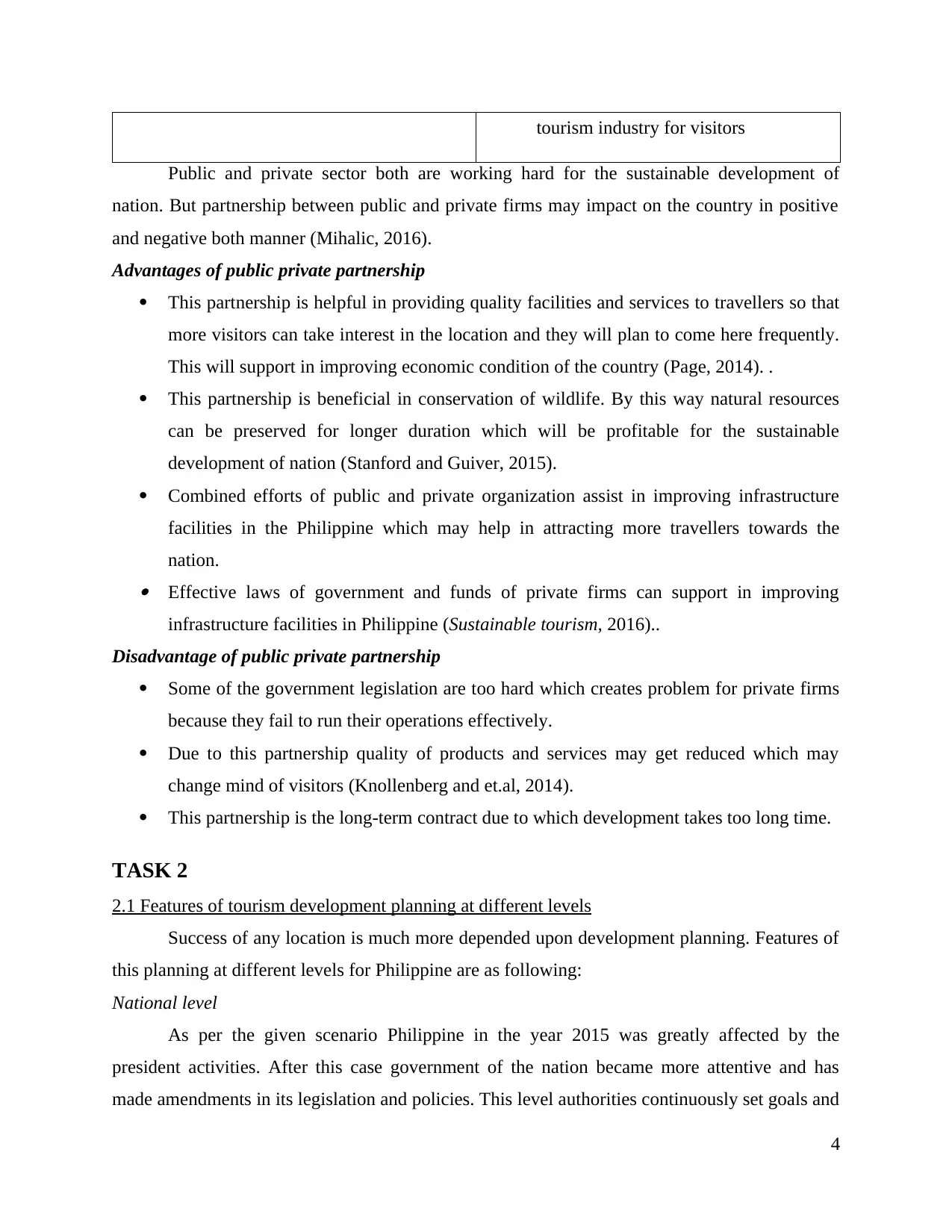
tourism industry for visitors
Public and private sector both are working hard for the sustainable development of
nation. But partnership between public and private firms may impact on the country in positive
and negative both manner (Mihalic, 2016).
Advantages of public private partnership
This partnership is helpful in providing quality facilities and services to travellers so that
more visitors can take interest in the location and they will plan to come here frequently.
This will support in improving economic condition of the country (Page, 2014). .
This partnership is beneficial in conservation of wildlife. By this way natural resources
can be preserved for longer duration which will be profitable for the sustainable
development of nation (Stanford and Guiver, 2015).
Combined efforts of public and private organization assist in improving infrastructure
facilities in the Philippine which may help in attracting more travellers towards the
nation. Effective laws of government and funds of private firms can support in improving
infrastructure facilities in Philippine (Sustainable tourism, 2016)..
Disadvantage of public private partnership
Some of the government legislation are too hard which creates problem for private firms
because they fail to run their operations effectively.
Due to this partnership quality of products and services may get reduced which may
change mind of visitors (Knollenberg and et.al, 2014).
This partnership is the long-term contract due to which development takes too long time.
TASK 2
2.1 Features of tourism development planning at different levels
Success of any location is much more depended upon development planning. Features of
this planning at different levels for Philippine are as following:
National level
As per the given scenario Philippine in the year 2015 was greatly affected by the
president activities. After this case government of the nation became more attentive and has
made amendments in its legislation and policies. This level authorities continuously set goals and
4
Public and private sector both are working hard for the sustainable development of
nation. But partnership between public and private firms may impact on the country in positive
and negative both manner (Mihalic, 2016).
Advantages of public private partnership
This partnership is helpful in providing quality facilities and services to travellers so that
more visitors can take interest in the location and they will plan to come here frequently.
This will support in improving economic condition of the country (Page, 2014). .
This partnership is beneficial in conservation of wildlife. By this way natural resources
can be preserved for longer duration which will be profitable for the sustainable
development of nation (Stanford and Guiver, 2015).
Combined efforts of public and private organization assist in improving infrastructure
facilities in the Philippine which may help in attracting more travellers towards the
nation. Effective laws of government and funds of private firms can support in improving
infrastructure facilities in Philippine (Sustainable tourism, 2016)..
Disadvantage of public private partnership
Some of the government legislation are too hard which creates problem for private firms
because they fail to run their operations effectively.
Due to this partnership quality of products and services may get reduced which may
change mind of visitors (Knollenberg and et.al, 2014).
This partnership is the long-term contract due to which development takes too long time.
TASK 2
2.1 Features of tourism development planning at different levels
Success of any location is much more depended upon development planning. Features of
this planning at different levels for Philippine are as following:
National level
As per the given scenario Philippine in the year 2015 was greatly affected by the
president activities. After this case government of the nation became more attentive and has
made amendments in its legislation and policies. This level authorities continuously set goals and
4
⊘ This is a preview!⊘
Do you want full access?
Subscribe today to unlock all pages.

Trusted by 1+ million students worldwide
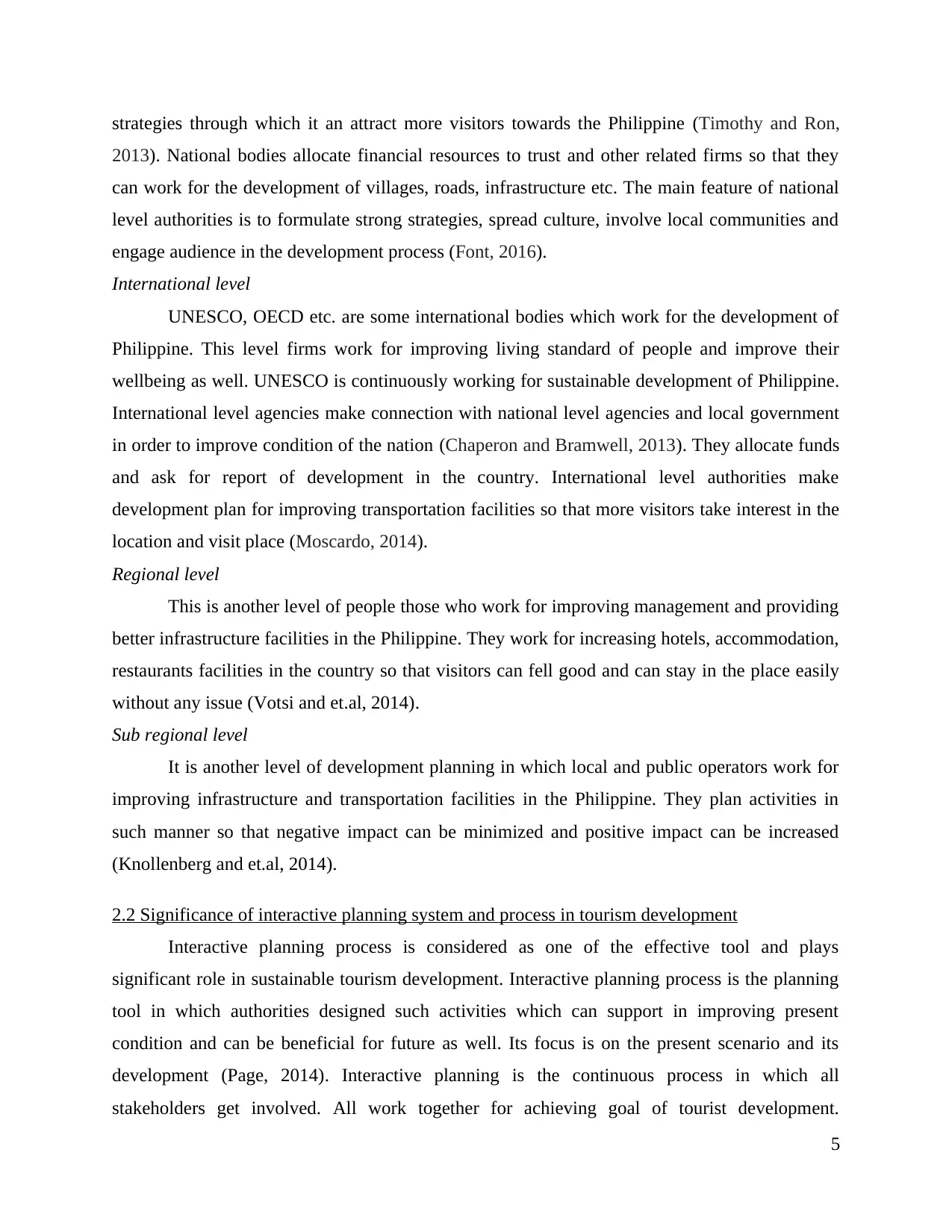
strategies through which it an attract more visitors towards the Philippine (Timothy and Ron,
2013). National bodies allocate financial resources to trust and other related firms so that they
can work for the development of villages, roads, infrastructure etc. The main feature of national
level authorities is to formulate strong strategies, spread culture, involve local communities and
engage audience in the development process (Font, 2016).
International level
UNESCO, OECD etc. are some international bodies which work for the development of
Philippine. This level firms work for improving living standard of people and improve their
wellbeing as well. UNESCO is continuously working for sustainable development of Philippine.
International level agencies make connection with national level agencies and local government
in order to improve condition of the nation (Chaperon and Bramwell, 2013). They allocate funds
and ask for report of development in the country. International level authorities make
development plan for improving transportation facilities so that more visitors take interest in the
location and visit place (Moscardo, 2014).
Regional level
This is another level of people those who work for improving management and providing
better infrastructure facilities in the Philippine. They work for increasing hotels, accommodation,
restaurants facilities in the country so that visitors can fell good and can stay in the place easily
without any issue (Votsi and et.al, 2014).
Sub regional level
It is another level of development planning in which local and public operators work for
improving infrastructure and transportation facilities in the Philippine. They plan activities in
such manner so that negative impact can be minimized and positive impact can be increased
(Knollenberg and et.al, 2014).
2.2 Significance of interactive planning system and process in tourism development
Interactive planning process is considered as one of the effective tool and plays
significant role in sustainable tourism development. Interactive planning process is the planning
tool in which authorities designed such activities which can support in improving present
condition and can be beneficial for future as well. Its focus is on the present scenario and its
development (Page, 2014). Interactive planning is the continuous process in which all
stakeholders get involved. All work together for achieving goal of tourist development.
5
2013). National bodies allocate financial resources to trust and other related firms so that they
can work for the development of villages, roads, infrastructure etc. The main feature of national
level authorities is to formulate strong strategies, spread culture, involve local communities and
engage audience in the development process (Font, 2016).
International level
UNESCO, OECD etc. are some international bodies which work for the development of
Philippine. This level firms work for improving living standard of people and improve their
wellbeing as well. UNESCO is continuously working for sustainable development of Philippine.
International level agencies make connection with national level agencies and local government
in order to improve condition of the nation (Chaperon and Bramwell, 2013). They allocate funds
and ask for report of development in the country. International level authorities make
development plan for improving transportation facilities so that more visitors take interest in the
location and visit place (Moscardo, 2014).
Regional level
This is another level of people those who work for improving management and providing
better infrastructure facilities in the Philippine. They work for increasing hotels, accommodation,
restaurants facilities in the country so that visitors can fell good and can stay in the place easily
without any issue (Votsi and et.al, 2014).
Sub regional level
It is another level of development planning in which local and public operators work for
improving infrastructure and transportation facilities in the Philippine. They plan activities in
such manner so that negative impact can be minimized and positive impact can be increased
(Knollenberg and et.al, 2014).
2.2 Significance of interactive planning system and process in tourism development
Interactive planning process is considered as one of the effective tool and plays
significant role in sustainable tourism development. Interactive planning process is the planning
tool in which authorities designed such activities which can support in improving present
condition and can be beneficial for future as well. Its focus is on the present scenario and its
development (Page, 2014). Interactive planning is the continuous process in which all
stakeholders get involved. All work together for achieving goal of tourist development.
5
Paraphrase This Document
Need a fresh take? Get an instant paraphrase of this document with our AI Paraphraser
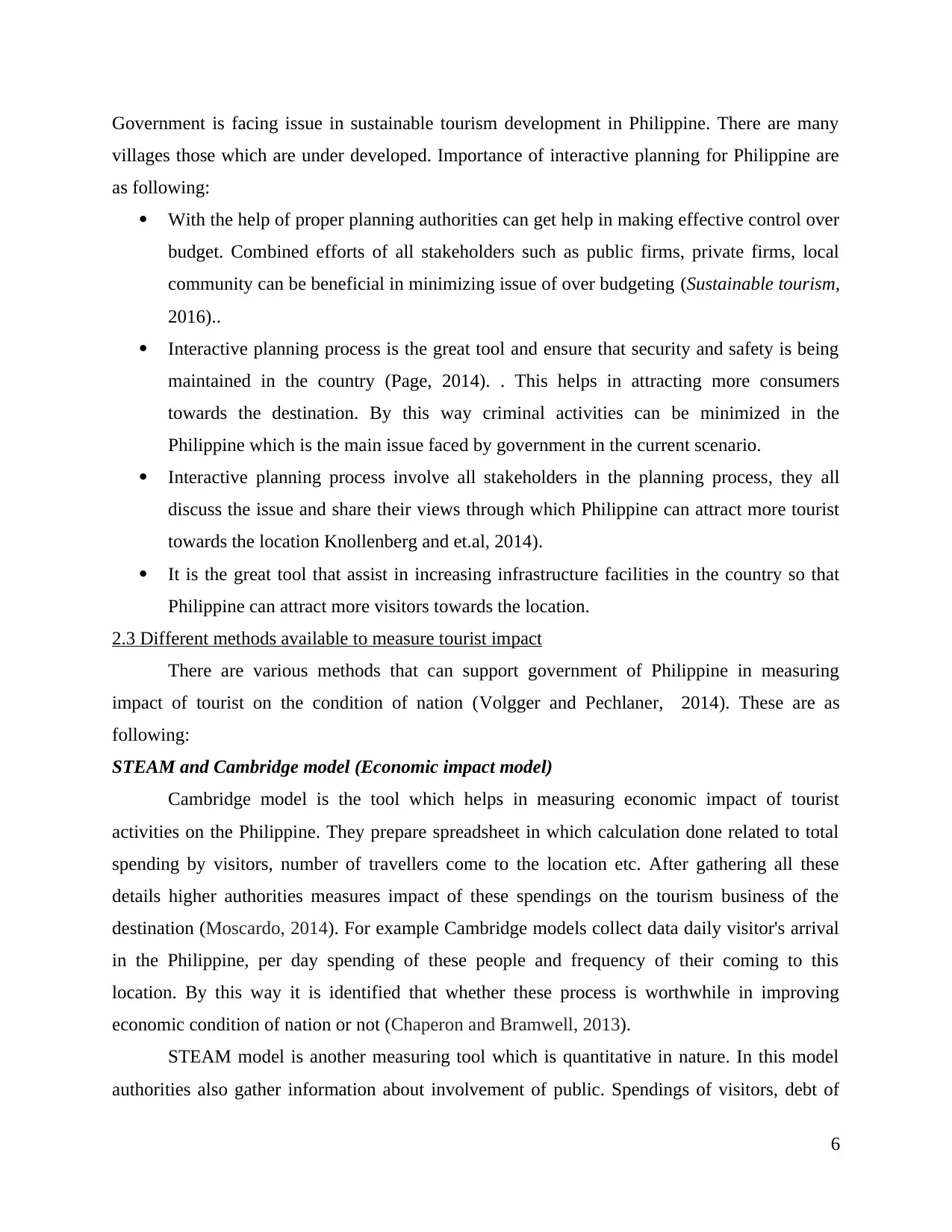
Government is facing issue in sustainable tourism development in Philippine. There are many
villages those which are under developed. Importance of interactive planning for Philippine are
as following:
With the help of proper planning authorities can get help in making effective control over
budget. Combined efforts of all stakeholders such as public firms, private firms, local
community can be beneficial in minimizing issue of over budgeting (Sustainable tourism,
2016)..
Interactive planning process is the great tool and ensure that security and safety is being
maintained in the country (Page, 2014). . This helps in attracting more consumers
towards the destination. By this way criminal activities can be minimized in the
Philippine which is the main issue faced by government in the current scenario.
Interactive planning process involve all stakeholders in the planning process, they all
discuss the issue and share their views through which Philippine can attract more tourist
towards the location Knollenberg and et.al, 2014).
It is the great tool that assist in increasing infrastructure facilities in the country so that
Philippine can attract more visitors towards the location.
2.3 Different methods available to measure tourist impact
There are various methods that can support government of Philippine in measuring
impact of tourist on the condition of nation (Volgger and Pechlaner, 2014). These are as
following:
STEAM and Cambridge model (Economic impact model)
Cambridge model is the tool which helps in measuring economic impact of tourist
activities on the Philippine. They prepare spreadsheet in which calculation done related to total
spending by visitors, number of travellers come to the location etc. After gathering all these
details higher authorities measures impact of these spendings on the tourism business of the
destination (Moscardo, 2014). For example Cambridge models collect data daily visitor's arrival
in the Philippine, per day spending of these people and frequency of their coming to this
location. By this way it is identified that whether these process is worthwhile in improving
economic condition of nation or not (Chaperon and Bramwell, 2013).
STEAM model is another measuring tool which is quantitative in nature. In this model
authorities also gather information about involvement of public. Spendings of visitors, debt of
6
villages those which are under developed. Importance of interactive planning for Philippine are
as following:
With the help of proper planning authorities can get help in making effective control over
budget. Combined efforts of all stakeholders such as public firms, private firms, local
community can be beneficial in minimizing issue of over budgeting (Sustainable tourism,
2016)..
Interactive planning process is the great tool and ensure that security and safety is being
maintained in the country (Page, 2014). . This helps in attracting more consumers
towards the destination. By this way criminal activities can be minimized in the
Philippine which is the main issue faced by government in the current scenario.
Interactive planning process involve all stakeholders in the planning process, they all
discuss the issue and share their views through which Philippine can attract more tourist
towards the location Knollenberg and et.al, 2014).
It is the great tool that assist in increasing infrastructure facilities in the country so that
Philippine can attract more visitors towards the location.
2.3 Different methods available to measure tourist impact
There are various methods that can support government of Philippine in measuring
impact of tourist on the condition of nation (Volgger and Pechlaner, 2014). These are as
following:
STEAM and Cambridge model (Economic impact model)
Cambridge model is the tool which helps in measuring economic impact of tourist
activities on the Philippine. They prepare spreadsheet in which calculation done related to total
spending by visitors, number of travellers come to the location etc. After gathering all these
details higher authorities measures impact of these spendings on the tourism business of the
destination (Moscardo, 2014). For example Cambridge models collect data daily visitor's arrival
in the Philippine, per day spending of these people and frequency of their coming to this
location. By this way it is identified that whether these process is worthwhile in improving
economic condition of nation or not (Chaperon and Bramwell, 2013).
STEAM model is another measuring tool which is quantitative in nature. In this model
authorities also gather information about involvement of public. Spendings of visitors, debt of
6
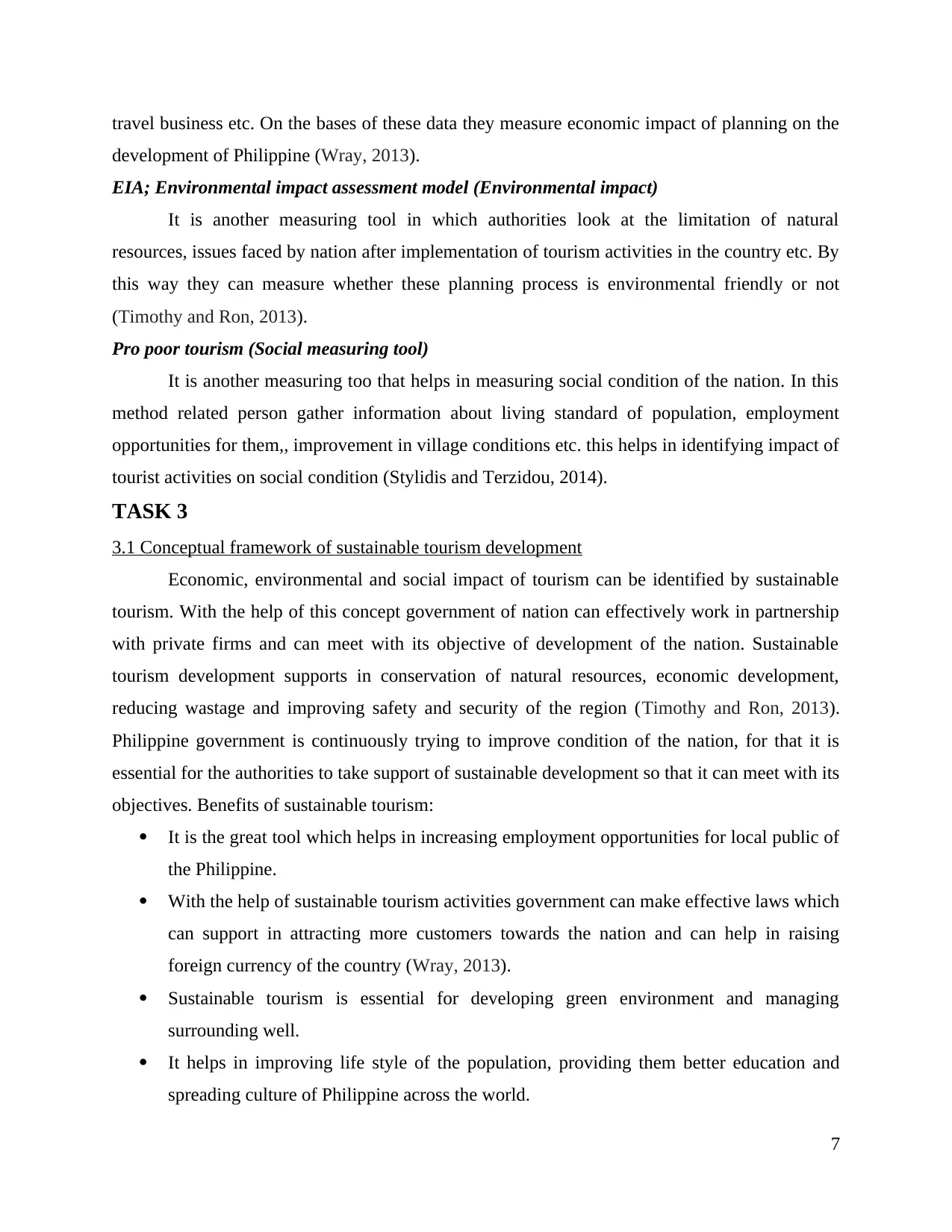
travel business etc. On the bases of these data they measure economic impact of planning on the
development of Philippine (Wray, 2013).
EIA; Environmental impact assessment model (Environmental impact)
It is another measuring tool in which authorities look at the limitation of natural
resources, issues faced by nation after implementation of tourism activities in the country etc. By
this way they can measure whether these planning process is environmental friendly or not
(Timothy and Ron, 2013).
Pro poor tourism (Social measuring tool)
It is another measuring too that helps in measuring social condition of the nation. In this
method related person gather information about living standard of population, employment
opportunities for them,, improvement in village conditions etc. this helps in identifying impact of
tourist activities on social condition (Stylidis and Terzidou, 2014).
TASK 3
3.1 Conceptual framework of sustainable tourism development
Economic, environmental and social impact of tourism can be identified by sustainable
tourism. With the help of this concept government of nation can effectively work in partnership
with private firms and can meet with its objective of development of the nation. Sustainable
tourism development supports in conservation of natural resources, economic development,
reducing wastage and improving safety and security of the region (Timothy and Ron, 2013).
Philippine government is continuously trying to improve condition of the nation, for that it is
essential for the authorities to take support of sustainable development so that it can meet with its
objectives. Benefits of sustainable tourism:
It is the great tool which helps in increasing employment opportunities for local public of
the Philippine.
With the help of sustainable tourism activities government can make effective laws which
can support in attracting more customers towards the nation and can help in raising
foreign currency of the country (Wray, 2013).
Sustainable tourism is essential for developing green environment and managing
surrounding well.
It helps in improving life style of the population, providing them better education and
spreading culture of Philippine across the world.
7
development of Philippine (Wray, 2013).
EIA; Environmental impact assessment model (Environmental impact)
It is another measuring tool in which authorities look at the limitation of natural
resources, issues faced by nation after implementation of tourism activities in the country etc. By
this way they can measure whether these planning process is environmental friendly or not
(Timothy and Ron, 2013).
Pro poor tourism (Social measuring tool)
It is another measuring too that helps in measuring social condition of the nation. In this
method related person gather information about living standard of population, employment
opportunities for them,, improvement in village conditions etc. this helps in identifying impact of
tourist activities on social condition (Stylidis and Terzidou, 2014).
TASK 3
3.1 Conceptual framework of sustainable tourism development
Economic, environmental and social impact of tourism can be identified by sustainable
tourism. With the help of this concept government of nation can effectively work in partnership
with private firms and can meet with its objective of development of the nation. Sustainable
tourism development supports in conservation of natural resources, economic development,
reducing wastage and improving safety and security of the region (Timothy and Ron, 2013).
Philippine government is continuously trying to improve condition of the nation, for that it is
essential for the authorities to take support of sustainable development so that it can meet with its
objectives. Benefits of sustainable tourism:
It is the great tool which helps in increasing employment opportunities for local public of
the Philippine.
With the help of sustainable tourism activities government can make effective laws which
can support in attracting more customers towards the nation and can help in raising
foreign currency of the country (Wray, 2013).
Sustainable tourism is essential for developing green environment and managing
surrounding well.
It helps in improving life style of the population, providing them better education and
spreading culture of Philippine across the world.
7
⊘ This is a preview!⊘
Do you want full access?
Subscribe today to unlock all pages.

Trusted by 1+ million students worldwide
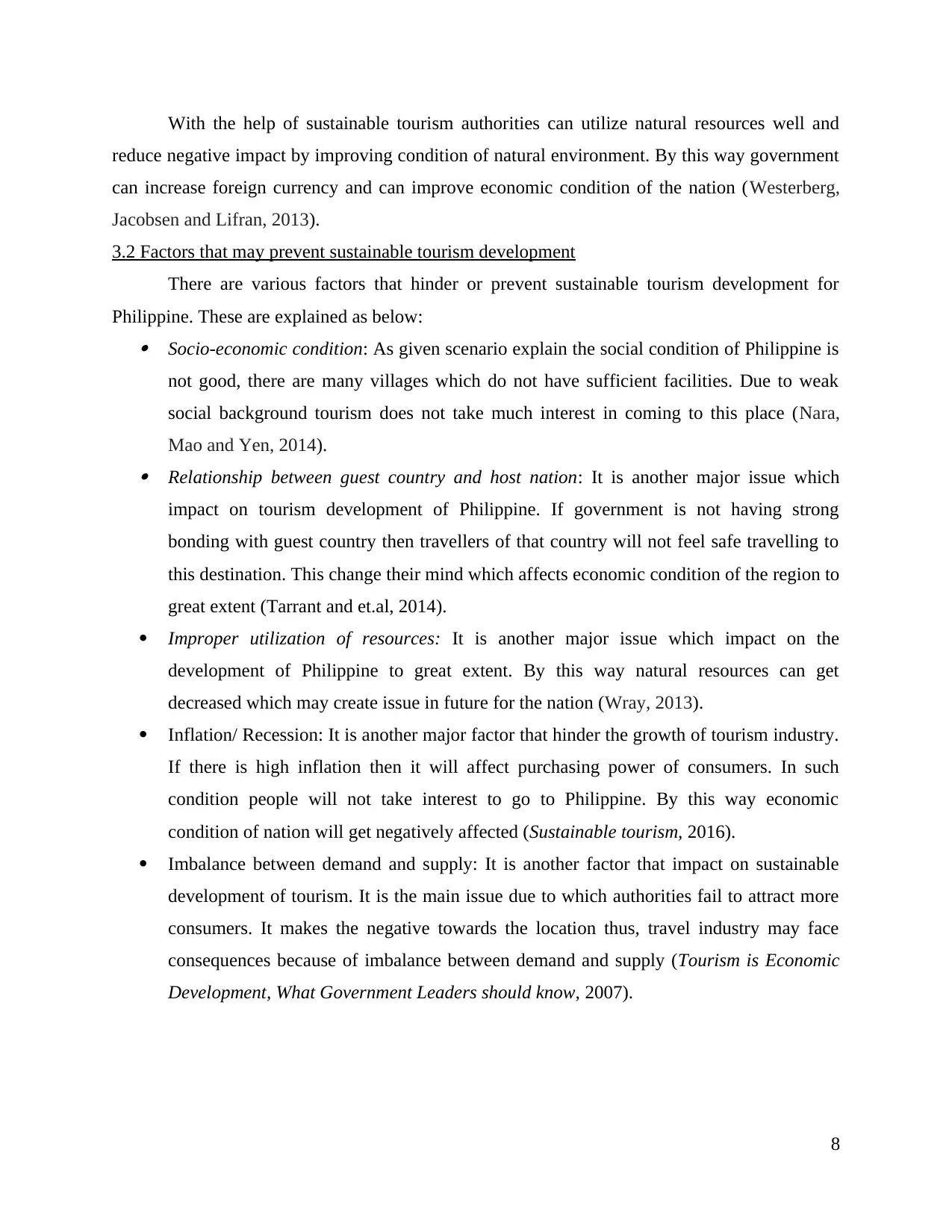
With the help of sustainable tourism authorities can utilize natural resources well and
reduce negative impact by improving condition of natural environment. By this way government
can increase foreign currency and can improve economic condition of the nation (Westerberg,
Jacobsen and Lifran, 2013).
3.2 Factors that may prevent sustainable tourism development
There are various factors that hinder or prevent sustainable tourism development for
Philippine. These are explained as below: Socio-economic condition: As given scenario explain the social condition of Philippine is
not good, there are many villages which do not have sufficient facilities. Due to weak
social background tourism does not take much interest in coming to this place (Nara,
Mao and Yen, 2014). Relationship between guest country and host nation: It is another major issue which
impact on tourism development of Philippine. If government is not having strong
bonding with guest country then travellers of that country will not feel safe travelling to
this destination. This change their mind which affects economic condition of the region to
great extent (Tarrant and et.al, 2014).
Improper utilization of resources: It is another major issue which impact on the
development of Philippine to great extent. By this way natural resources can get
decreased which may create issue in future for the nation (Wray, 2013).
Inflation/ Recession: It is another major factor that hinder the growth of tourism industry.
If there is high inflation then it will affect purchasing power of consumers. In such
condition people will not take interest to go to Philippine. By this way economic
condition of nation will get negatively affected (Sustainable tourism, 2016).
Imbalance between demand and supply: It is another factor that impact on sustainable
development of tourism. It is the main issue due to which authorities fail to attract more
consumers. It makes the negative towards the location thus, travel industry may face
consequences because of imbalance between demand and supply (Tourism is Economic
Development, What Government Leaders should know, 2007).
8
reduce negative impact by improving condition of natural environment. By this way government
can increase foreign currency and can improve economic condition of the nation (Westerberg,
Jacobsen and Lifran, 2013).
3.2 Factors that may prevent sustainable tourism development
There are various factors that hinder or prevent sustainable tourism development for
Philippine. These are explained as below: Socio-economic condition: As given scenario explain the social condition of Philippine is
not good, there are many villages which do not have sufficient facilities. Due to weak
social background tourism does not take much interest in coming to this place (Nara,
Mao and Yen, 2014). Relationship between guest country and host nation: It is another major issue which
impact on tourism development of Philippine. If government is not having strong
bonding with guest country then travellers of that country will not feel safe travelling to
this destination. This change their mind which affects economic condition of the region to
great extent (Tarrant and et.al, 2014).
Improper utilization of resources: It is another major issue which impact on the
development of Philippine to great extent. By this way natural resources can get
decreased which may create issue in future for the nation (Wray, 2013).
Inflation/ Recession: It is another major factor that hinder the growth of tourism industry.
If there is high inflation then it will affect purchasing power of consumers. In such
condition people will not take interest to go to Philippine. By this way economic
condition of nation will get negatively affected (Sustainable tourism, 2016).
Imbalance between demand and supply: It is another factor that impact on sustainable
development of tourism. It is the main issue due to which authorities fail to attract more
consumers. It makes the negative towards the location thus, travel industry may face
consequences because of imbalance between demand and supply (Tourism is Economic
Development, What Government Leaders should know, 2007).
8
Paraphrase This Document
Need a fresh take? Get an instant paraphrase of this document with our AI Paraphraser
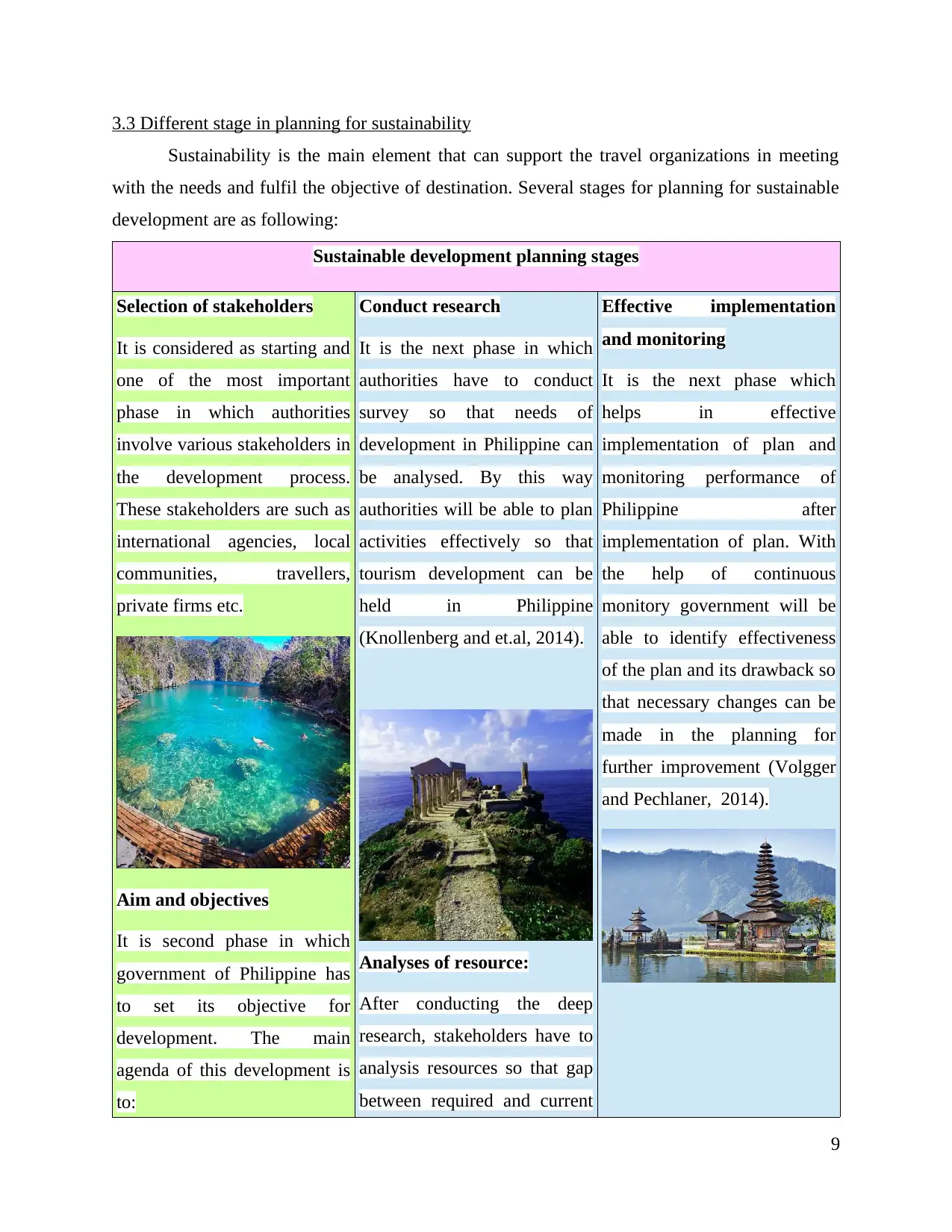
3.3 Different stage in planning for sustainability
Sustainability is the main element that can support the travel organizations in meeting
with the needs and fulfil the objective of destination. Several stages for planning for sustainable
development are as following:
Sustainable development planning stages
Selection of stakeholders
It is considered as starting and
one of the most important
phase in which authorities
involve various stakeholders in
the development process.
These stakeholders are such as
international agencies, local
communities, travellers,
private firms etc.
Aim and objectives
It is second phase in which
government of Philippine has
to set its objective for
development. The main
agenda of this development is
to:
Conduct research
It is the next phase in which
authorities have to conduct
survey so that needs of
development in Philippine can
be analysed. By this way
authorities will be able to plan
activities effectively so that
tourism development can be
held in Philippine
(Knollenberg and et.al, 2014).
Analyses of resource:
After conducting the deep
research, stakeholders have to
analysis resources so that gap
between required and current
Effective implementation
and monitoring
It is the next phase which
helps in effective
implementation of plan and
monitoring performance of
Philippine after
implementation of plan. With
the help of continuous
monitory government will be
able to identify effectiveness
of the plan and its drawback so
that necessary changes can be
made in the planning for
further improvement (Volgger
and Pechlaner, 2014).
9
Sustainability is the main element that can support the travel organizations in meeting
with the needs and fulfil the objective of destination. Several stages for planning for sustainable
development are as following:
Sustainable development planning stages
Selection of stakeholders
It is considered as starting and
one of the most important
phase in which authorities
involve various stakeholders in
the development process.
These stakeholders are such as
international agencies, local
communities, travellers,
private firms etc.
Aim and objectives
It is second phase in which
government of Philippine has
to set its objective for
development. The main
agenda of this development is
to:
Conduct research
It is the next phase in which
authorities have to conduct
survey so that needs of
development in Philippine can
be analysed. By this way
authorities will be able to plan
activities effectively so that
tourism development can be
held in Philippine
(Knollenberg and et.al, 2014).
Analyses of resource:
After conducting the deep
research, stakeholders have to
analysis resources so that gap
between required and current
Effective implementation
and monitoring
It is the next phase which
helps in effective
implementation of plan and
monitoring performance of
Philippine after
implementation of plan. With
the help of continuous
monitory government will be
able to identify effectiveness
of the plan and its drawback so
that necessary changes can be
made in the planning for
further improvement (Volgger
and Pechlaner, 2014).
9
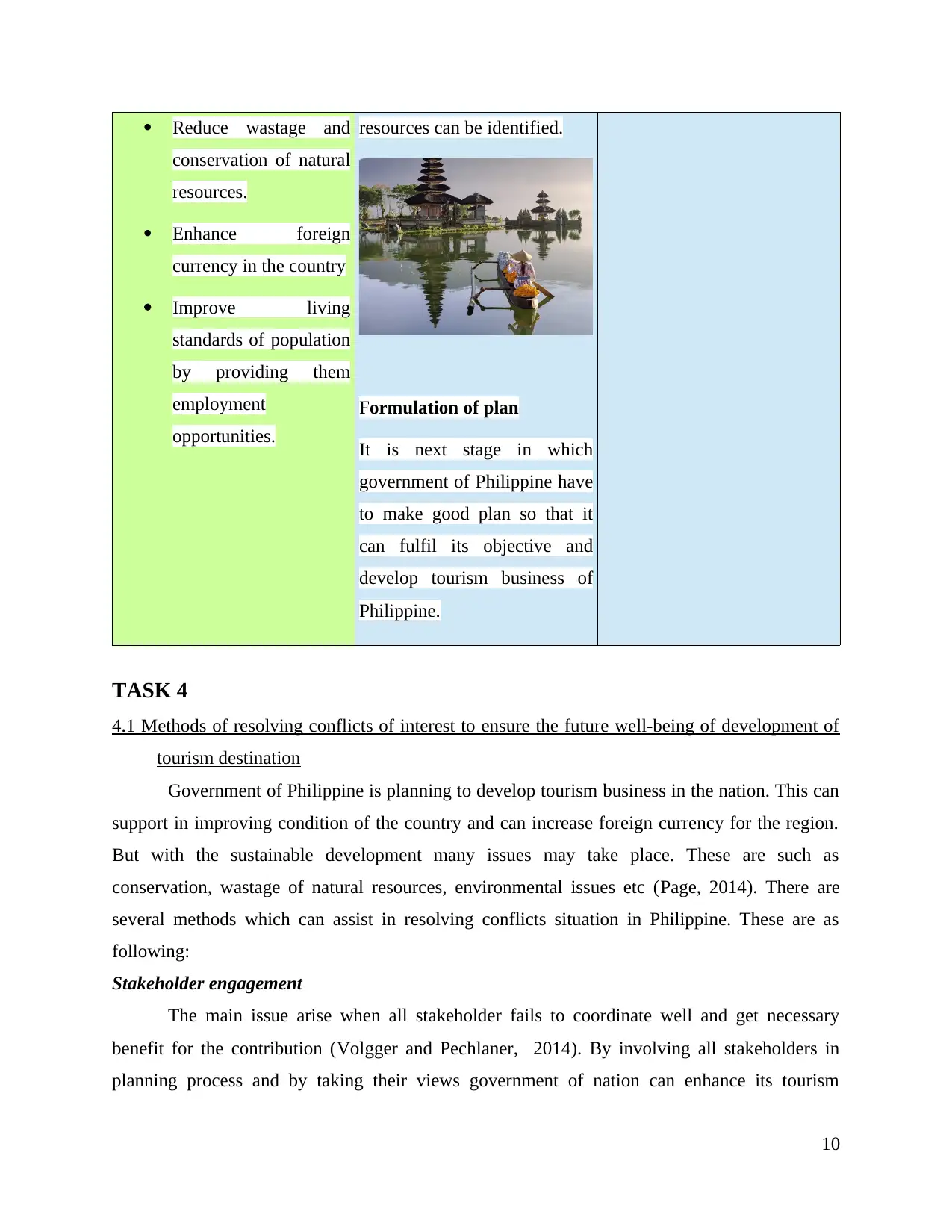
Reduce wastage and
conservation of natural
resources.
Enhance foreign
currency in the country
Improve living
standards of population
by providing them
employment
opportunities.
resources can be identified.
Formulation of plan
It is next stage in which
government of Philippine have
to make good plan so that it
can fulfil its objective and
develop tourism business of
Philippine.
TASK 4
4.1 Methods of resolving conflicts of interest to ensure the future well-being of development of
tourism destination
Government of Philippine is planning to develop tourism business in the nation. This can
support in improving condition of the country and can increase foreign currency for the region.
But with the sustainable development many issues may take place. These are such as
conservation, wastage of natural resources, environmental issues etc (Page, 2014). There are
several methods which can assist in resolving conflicts situation in Philippine. These are as
following:
Stakeholder engagement
The main issue arise when all stakeholder fails to coordinate well and get necessary
benefit for the contribution (Volgger and Pechlaner, 2014). By involving all stakeholders in
planning process and by taking their views government of nation can enhance its tourism
10
conservation of natural
resources.
Enhance foreign
currency in the country
Improve living
standards of population
by providing them
employment
opportunities.
resources can be identified.
Formulation of plan
It is next stage in which
government of Philippine have
to make good plan so that it
can fulfil its objective and
develop tourism business of
Philippine.
TASK 4
4.1 Methods of resolving conflicts of interest to ensure the future well-being of development of
tourism destination
Government of Philippine is planning to develop tourism business in the nation. This can
support in improving condition of the country and can increase foreign currency for the region.
But with the sustainable development many issues may take place. These are such as
conservation, wastage of natural resources, environmental issues etc (Page, 2014). There are
several methods which can assist in resolving conflicts situation in Philippine. These are as
following:
Stakeholder engagement
The main issue arise when all stakeholder fails to coordinate well and get necessary
benefit for the contribution (Volgger and Pechlaner, 2014). By involving all stakeholders in
planning process and by taking their views government of nation can enhance its tourism
10
⊘ This is a preview!⊘
Do you want full access?
Subscribe today to unlock all pages.

Trusted by 1+ million students worldwide
1 out of 19
Related Documents
Your All-in-One AI-Powered Toolkit for Academic Success.
+13062052269
info@desklib.com
Available 24*7 on WhatsApp / Email
![[object Object]](/_next/static/media/star-bottom.7253800d.svg)
Unlock your academic potential
Copyright © 2020–2025 A2Z Services. All Rights Reserved. Developed and managed by ZUCOL.





